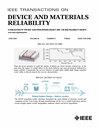Utilizing Two Three-Transistor Structures for Designing Radiation Hardened Circuits
IF 2.5
3区 工程技术
Q2 ENGINEERING, ELECTRICAL & ELECTRONIC
IEEE Transactions on Device and Materials Reliability
Pub Date : 2023-12-20
DOI:10.1109/TDMR.2023.3344767
引用次数: 0
Abstract
This paper focuses on two types of three-transistor structures, known as PNN and PPN, which represent the number of PMOS and NMOS transistors in each configuration. These structures are characterized by their unidirectional flip at the output nodes, as they are spatially surrounded by N-type and P-type diffusion regions respectively. This characteristic makes them suitable for designing radiation-hardened circuits, particularly for Single Event Upset (SEU) tolerance. Three dimensional (3-D) simulations demonstrate that when exposed to energetic particles, the node surrounded by N-type diffusion remains immune to 0利用两个三晶体管结构设计抗辐射电路
本文的重点是两种三晶体管结构,即 PNN 和 PPN,它们分别代表每个配置中 PMOS 和 NMOS 晶体管的数量。这些结构的特点是输出节点单向翻转,因为它们在空间上分别被 N 型和 P 型扩散区包围。这一特性使它们适用于设计辐射加固电路,特别是单事件猝发(SEU)耐受性。三维(3-D)仿真表明,当暴露在高能粒子中时,被N型扩散环绕的节点仍能抵御0次翻转,而被P型扩散环绕的节点仍能抵御1次翻转。此外,所提出的三晶体管块可确保永远不会形成从电源到地的导电路径,从而防止功耗过高。在这些独特结构的基础上,我们提出了两个面积效率高的单节点猝发(SNU)容错锁存器和两个双节点猝发(DNU)可恢复锁存器。大量仿真证实,我们提出的锁存器(分别称为 SNUTL-PNN、SNUTL-PPN、DNURL-PNN 和 DNURL-PPN)在输出节点方面表现出卓越的自恢复能力。与其他设计相比,本文提出的锁存器在面积和功耗方面更具优势。此外,我们还将 PNN 和 PPN 的变体应用于动态触发器 True Single Phase Clock (TSPC),该触发器通常以较低的功耗高速运行。我们引入的加固方案占用的面积最小,传播延迟短,在正常工作条件下功耗相对较低。
本文章由计算机程序翻译,如有差异,请以英文原文为准。
求助全文
约1分钟内获得全文
求助全文
来源期刊

IEEE Transactions on Device and Materials Reliability
工程技术-工程:电子与电气
CiteScore
4.80
自引率
5.00%
发文量
71
审稿时长
6-12 weeks
期刊介绍:
The scope of the publication includes, but is not limited to Reliability of: Devices, Materials, Processes, Interfaces, Integrated Microsystems (including MEMS & Sensors), Transistors, Technology (CMOS, BiCMOS, etc.), Integrated Circuits (IC, SSI, MSI, LSI, ULSI, ELSI, etc.), Thin Film Transistor Applications. The measurement and understanding of the reliability of such entities at each phase, from the concept stage through research and development and into manufacturing scale-up, provides the overall database on the reliability of the devices, materials, processes, package and other necessities for the successful introduction of a product to market. This reliability database is the foundation for a quality product, which meets customer expectation. A product so developed has high reliability. High quality will be achieved because product weaknesses will have been found (root cause analysis) and designed out of the final product. This process of ever increasing reliability and quality will result in a superior product. In the end, reliability and quality are not one thing; but in a sense everything, which can be or has to be done to guarantee that the product successfully performs in the field under customer conditions. Our goal is to capture these advances. An additional objective is to focus cross fertilized communication in the state of the art of reliability of electronic materials and devices and provide fundamental understanding of basic phenomena that affect reliability. In addition, the publication is a forum for interdisciplinary studies on reliability. An overall goal is to provide leading edge/state of the art information, which is critically relevant to the creation of reliable products.
 求助内容:
求助内容: 应助结果提醒方式:
应助结果提醒方式:


